Cattle are essential for maintaining and enhancing the species rich grassland found at Slievenacloy in the Belfast Hills.
Local charity Ulster Wildlife own the nature reserve situated between Stoneyford and Divis Mountain.
Crumlin farmers Michael (pictured) and Judy Meharg rent 120 hectares from Ulster Wildlife at Slievenacloy for conservation grazing. Michael explained that the main aim of this practice is to improve the diversity and range of species present in the sward.
Suckler cows typically graze the land from May through to December at low stocking rates of around one livestock unit per hectare.
Land type
“That is just the average stocking rate for the whole year, so you can increase that to two livestock units for six months of the year,” Michael said.
Different types of cattle graze the reserve, including the native breed Irish Moiled. These cattle have a “browsing” grazing behaviour, so they graze across land selecting certain plants.

Heath spotted orchid.
“It is later in the year when they do the best conservation by grazing off bits that they have left alone earlier in the year,” Michael said.
There are more common beef breeds on the hill too. These have a less selective grazing behaviour than Irish Moiled and include the likes of Aberdeen Angus and Simmental cross cows.
“Simmentals are originally an upland breed from Germany, so they are suited to this type of land too,” Michael said.
The land at Slievenacloy could be described as dry, green hill.
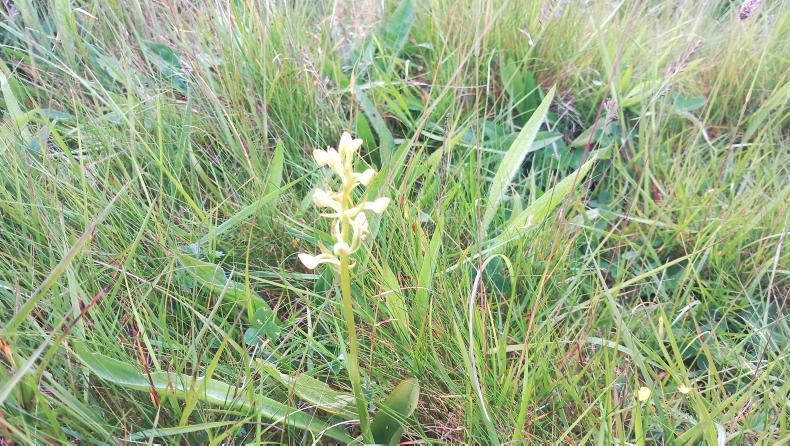
Butterfly orchid.
There is no heather or blanket bog and most of the land is stoney and free draining. Indeed, the name Slievenacloy roughly translates as “hill of the stoney place”.
Most of the land is under the “purple moorgrass and rush pasture” option in the higher level of the Environmental Farming Scheme (EFS).
Whilst Michael and Judy pay rent and claim the Basic Payment Scheme on the land, Ulster Wildlife claims the EFS payment.
Getting the balance right with grazing
The cattle at Slievenacloy help drive sward diversity as they graze off long grass and dead plant material which allows seedlings to grow the following spring.
If cattle were not grazing this land, a thatch of dense vegetation would form and the number of species growing in the sward would decline.
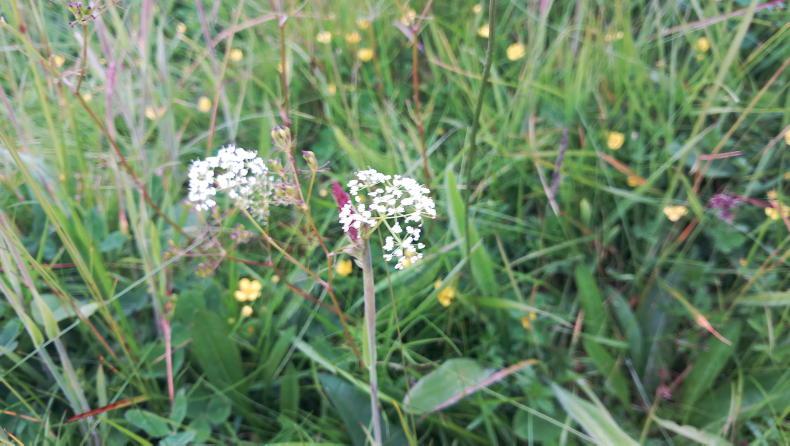
Pignut wildflower.
“It’s about trying to get the balance right by grazing down to the right level.
“We don’t want too much thatch left in the sward over the winter, but we also don’t want to be overgrazing either,” Michael said.
“The trick is to look down and see what is happening below your feet. We try to be flexible and try to not to get fixated by calendar dates,” he added.

Michael Meharg.
The remains of an old ringfort, which was used centuries ago for protection and to enclose cattle, is clearly seen at Slievenacloy.
With cattle grazing these hills for so long, it seems little wonder there is a mutually beneficial relationship between nature and farming.
Species
Michael’s cattle are doing a good job at promoting biodiversity. There is a mosaic of different grasses, herbs, and wildflowers growing on the site.
Cold weather has meant wildflowers are a few weeks later this year, although several species were starting to flower when the Irish Farmers Journal visited in mid-June.
Michael pointed out a range of wildflowers, including pignut, butterfly orchid, and heath spotted orchid.
The biodiversity at Slievenacloy goes beyond the different plants growing in the sward.
The site has a wide range of birdlife, including cuckoo, merlin, grasshopper warbler, meadow pipit and skylarks.
There are 12 species of butterflies and the common lizard, which is the only type of reptile found in Ireland, can also be seen on the site.
“There is waxcap fungi here too. It is an indicator of old, diverse grassland pasture. Surveys have found Slievenacloy is the third best site in Ireland for this type of fungi,” Michael said.
Low input, low output suckler beef system
Michael and Judy Meharg run a herd of 55 suckler cows across various sites in a low input system.
At the end of December, the cattle that have been grazing at Slievenacloy all year are housed at bed and breakfast wintering facilities where slurry goes to an anaerobic digestion plant.
It is a short winter because in early March cattle go to another nature reserve near Ballymena where Michael and Judy also rent land for conservation grazing. This land is a very different habitat to Slievenacloy as it is mainly a low laying flood plain along the River Braid.

Cows in the Meharg herd usually calve in April and May.
When cattle move to Slievenacloy in the late spring/early summer, they tend to stay there for the remainder of the year.
The hill is split into large blocks and cattle are moved between different parcels of land throughout the grazing season.
There are modern livestock handling facilities on the site too. There are no artificial fertilisers or chemical sprays used on any of the land at Slievenacloy, plus there is no supplementary feeding with concentrates or fodder.
Calving and sales
Michael tries to keep wormer treatments on livestock to a minimum as it can negatively affect dung beetles and other invertebrates in the soil.
“We only use a yellow (levamisole-based) drench, but we never do blanket treatments.
“We only dose an animal if it isn’t doing well,” he said.
Cows typically calve down in April and May, although a batch of Irish Moiled cows are calving later this year due to fertility issues with a bull.
Heifer calves from the Irish Moiled herd are either kept for replacements or sold as breeding stock.
Bullocks are kept through to beef in a low input system with most animals not slaughtered until 36 months of age. The Irish Moiled beef is mainly sold as a premium product directly to consumers through a “beef box” initiative.
The continental bred calves are sold as weanlings at the end of the year, as a key aim for the Mehargs is to avoid extra costs with wintering young cattle.
“If our most expensive inputs are sunshine and rain, then it is easier to make a profit,” Michael said.
Cattle are essential for maintaining and enhancing the species rich grassland found at Slievenacloy in the Belfast Hills.
Local charity Ulster Wildlife own the nature reserve situated between Stoneyford and Divis Mountain.
Crumlin farmers Michael (pictured) and Judy Meharg rent 120 hectares from Ulster Wildlife at Slievenacloy for conservation grazing. Michael explained that the main aim of this practice is to improve the diversity and range of species present in the sward.
Suckler cows typically graze the land from May through to December at low stocking rates of around one livestock unit per hectare.
Land type
“That is just the average stocking rate for the whole year, so you can increase that to two livestock units for six months of the year,” Michael said.
Different types of cattle graze the reserve, including the native breed Irish Moiled. These cattle have a “browsing” grazing behaviour, so they graze across land selecting certain plants.

Heath spotted orchid.
“It is later in the year when they do the best conservation by grazing off bits that they have left alone earlier in the year,” Michael said.
There are more common beef breeds on the hill too. These have a less selective grazing behaviour than Irish Moiled and include the likes of Aberdeen Angus and Simmental cross cows.
“Simmentals are originally an upland breed from Germany, so they are suited to this type of land too,” Michael said.
The land at Slievenacloy could be described as dry, green hill.

Butterfly orchid.
There is no heather or blanket bog and most of the land is stoney and free draining. Indeed, the name Slievenacloy roughly translates as “hill of the stoney place”.
Most of the land is under the “purple moorgrass and rush pasture” option in the higher level of the Environmental Farming Scheme (EFS).
Whilst Michael and Judy pay rent and claim the Basic Payment Scheme on the land, Ulster Wildlife claims the EFS payment.
Getting the balance right with grazing
The cattle at Slievenacloy help drive sward diversity as they graze off long grass and dead plant material which allows seedlings to grow the following spring.
If cattle were not grazing this land, a thatch of dense vegetation would form and the number of species growing in the sward would decline.

Pignut wildflower.
“It’s about trying to get the balance right by grazing down to the right level.
“We don’t want too much thatch left in the sward over the winter, but we also don’t want to be overgrazing either,” Michael said.
“The trick is to look down and see what is happening below your feet. We try to be flexible and try to not to get fixated by calendar dates,” he added.

Michael Meharg.
The remains of an old ringfort, which was used centuries ago for protection and to enclose cattle, is clearly seen at Slievenacloy.
With cattle grazing these hills for so long, it seems little wonder there is a mutually beneficial relationship between nature and farming.
Species
Michael’s cattle are doing a good job at promoting biodiversity. There is a mosaic of different grasses, herbs, and wildflowers growing on the site.
Cold weather has meant wildflowers are a few weeks later this year, although several species were starting to flower when the Irish Farmers Journal visited in mid-June.
Michael pointed out a range of wildflowers, including pignut, butterfly orchid, and heath spotted orchid.
The biodiversity at Slievenacloy goes beyond the different plants growing in the sward.
The site has a wide range of birdlife, including cuckoo, merlin, grasshopper warbler, meadow pipit and skylarks.
There are 12 species of butterflies and the common lizard, which is the only type of reptile found in Ireland, can also be seen on the site.
“There is waxcap fungi here too. It is an indicator of old, diverse grassland pasture. Surveys have found Slievenacloy is the third best site in Ireland for this type of fungi,” Michael said.
Low input, low output suckler beef system
Michael and Judy Meharg run a herd of 55 suckler cows across various sites in a low input system.
At the end of December, the cattle that have been grazing at Slievenacloy all year are housed at bed and breakfast wintering facilities where slurry goes to an anaerobic digestion plant.
It is a short winter because in early March cattle go to another nature reserve near Ballymena where Michael and Judy also rent land for conservation grazing. This land is a very different habitat to Slievenacloy as it is mainly a low laying flood plain along the River Braid.

Cows in the Meharg herd usually calve in April and May.
When cattle move to Slievenacloy in the late spring/early summer, they tend to stay there for the remainder of the year.
The hill is split into large blocks and cattle are moved between different parcels of land throughout the grazing season.
There are modern livestock handling facilities on the site too. There are no artificial fertilisers or chemical sprays used on any of the land at Slievenacloy, plus there is no supplementary feeding with concentrates or fodder.
Calving and sales
Michael tries to keep wormer treatments on livestock to a minimum as it can negatively affect dung beetles and other invertebrates in the soil.
“We only use a yellow (levamisole-based) drench, but we never do blanket treatments.
“We only dose an animal if it isn’t doing well,” he said.
Cows typically calve down in April and May, although a batch of Irish Moiled cows are calving later this year due to fertility issues with a bull.
Heifer calves from the Irish Moiled herd are either kept for replacements or sold as breeding stock.
Bullocks are kept through to beef in a low input system with most animals not slaughtered until 36 months of age. The Irish Moiled beef is mainly sold as a premium product directly to consumers through a “beef box” initiative.
The continental bred calves are sold as weanlings at the end of the year, as a key aim for the Mehargs is to avoid extra costs with wintering young cattle.
“If our most expensive inputs are sunshine and rain, then it is easier to make a profit,” Michael said.










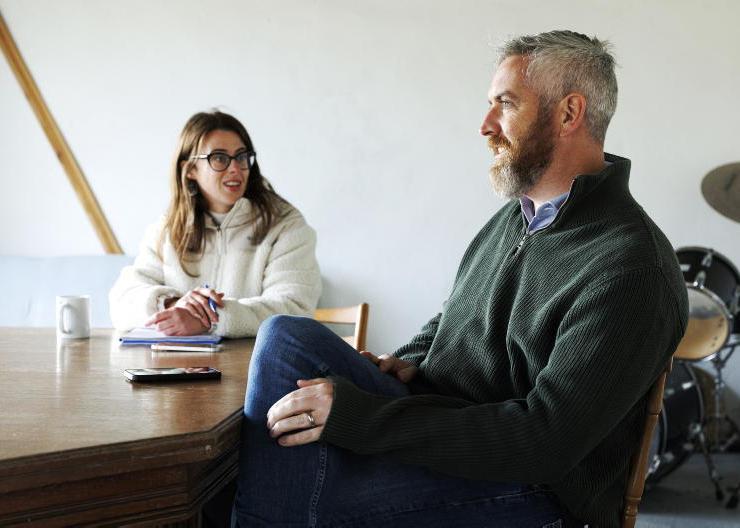

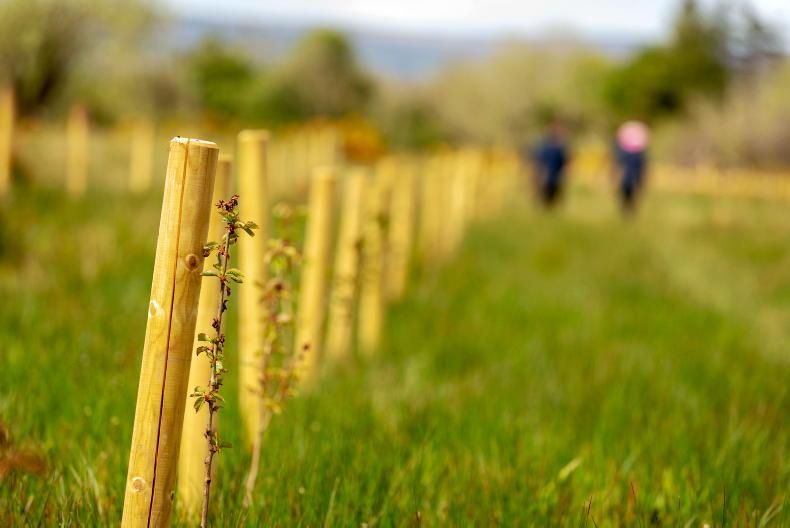
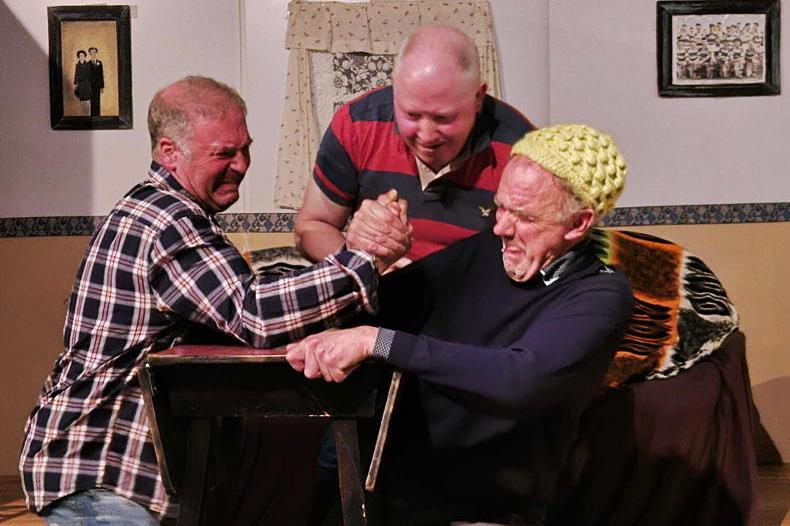
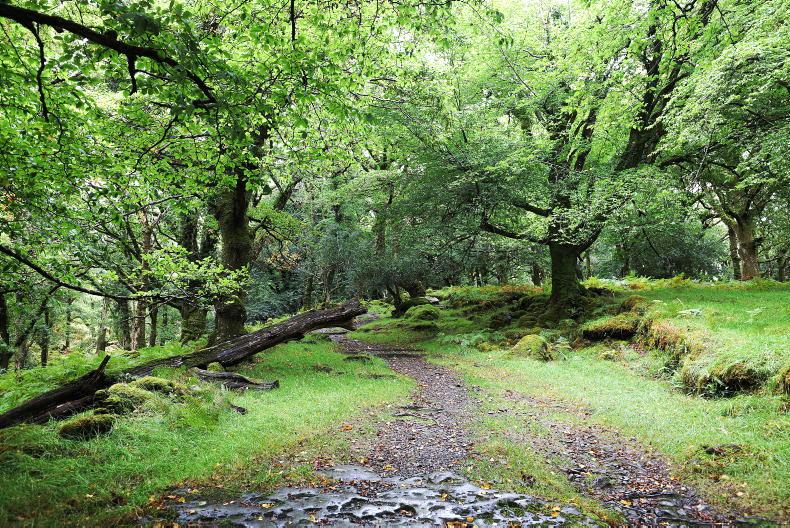
SHARING OPTIONS